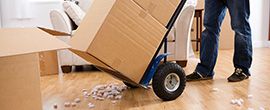Transitioning Homes Without the Stress
Posted on 25/05/2025
Transitioning Homes Without the Stress: Your Complete Guide
Moving to a new house can be one of life's most exciting adventures, but it often comes with its fair share of anxiety and challenges. Yet, it doesn't have to be overwhelming! With the right strategies and mindset, transitioning homes without the stress is absolutely achievable. This comprehensive guide uncovers essential steps, expert advice, and the best tips for a stress-free home transition, ensuring you settle into your new space with ease and happiness.

Why Is Home Transitioning So Stressful?
Moving represents significant change. Whether you're downsizing, upsizing, or just relocating, the sheer volume of decisions--from packing your belongings to forming new routines--can leave even the most organized person feeling unsettled. Understanding these common pain points is the first step toward moving homes without the stress:
- Emotional Attachment: Letting go of a cherished environment can spark nostalgia and anxiety.
- Logistics Overload: Coordinating movers, utilities, and timelines creates logistical headaches.
- Unpredictable Issues: Unexpected problems, such as delays or damaged items, can easily arise.
- Financial Pressure: Costs quickly add up and catching unforeseen expenses off guard.
Despite these challenges, homeowners and renters alike can benefit from a more mindful, systematic approach. Let's explore actionable steps to ensure your next transition is smooth and virtually stress-free!
Step-by-step Process for A Stress-Free Home Transition
1. Plan Early and Create a Moving Timeline
Preparation is the foundation of transitioning to a new home without stress. Begin planning as soon as possible--ideally, six to eight weeks before your moving date. Develop a checklist and assign dates for each phase of relocating homes.
- Define your preferred move-out and move-in dates
- Research and book a reputable moving company early on
- Notify landlords or realtors about your timeline
- Arrange time off work or childcare if needed
Thinking proactively will help avoid last-minute surprises and energy drain.
2. Declutter and Downsize
One cardinal rule for stress-free home moves is to get rid of anything you no longer want, need, or use. This is the perfect opportunity to declutter your life and travel lighter into your new space. Consider these steps:
- Go room by room. Systematically sort through each area of your home.
- Use the three-box method: Keep, donate/sell, toss.
- Host a garage sale or list items online. Earning some extra cash can offset moving costs!
- Dispose of hazardous materials and perishables responsibly.
Not only does decluttering streamline packing, but it also brings clarity, making your entire move less taxing and more fulfilling.
3. Organize Packing for Minimal Stress
Packing is often the most arduous part of changing homes without the stress. Avoid chaos by:
- Gathering quality packing materials early--boxes, tape, bubble wrap, labels, and markers.
- Packing non-essential items first, such as off-season clothes or infrequently used kitchenware.
- Labeling each box with its destination room and a brief description of its contents.
- Keeping important documents and valuables (passports, jewelry) with you in a clearly marked box or bag.
- Taking photos of electronics to remember how to reconnect wires easily.
Organizational hacks like color-coding boxes or using clear bins for essentials can further minimize the burden on moving day.
4. Inform and Update
Don't overlook the critical task of updating your contact information to ensure a smooth transition into your new house:
- Notify the post office and set up mail forwarding
- Update banks, utilities, subscriptions, and insurance providers with your new address
- Inform friends and family
- Arrange utility shut-off and activation dates for both homes
This step prevents confusion, missed bills, or service disruptions, helping maintain your day-to-day comfort while transitioning homes without the stress.
5. Pack a Moving Day Essentials Kit
On moving day, you'll need quick access to certain items--think of a suitcase for the first night in your new home. These should include:
- Medications and toiletries
- Pet and child supplies
- Chargers and electronics
- Clean clothes and basic kitchenware
- Important paperwork and moving contracts
Having these handy can stave off panic and ensure everyone's immediate needs are met, making your move as stress-free as possible.
6. Enlist Help and Delegate Tasks
You don't have to do it all! Friends, family, or professional movers can share the load. Assign tasks based on each person's strengths and comfort level. Even a few extra hands packing, cleaning, or watching the kids can make a noticeable difference in reducing moving stress.
If budgeting for professional moving services, consider options that also offer packing, storage, or cleaning for the ultimate hands-off experience.
7. Make Your New Place Move-In Ready
Before hauling in your first box, ensure your new space is prepped for living:
- Clean thoroughly or hire a cleaning service
- Double-check that all appliances work
- Test locks, smoke detectors, and utilities
- Stock bathrooms and kitchen with first-day basics
This proactive approach supports a calm, welcoming arrival and time to focus on settling in, free from stress and distractions.
Expert Tips for Settling In Without Worry
Give Yourself Time to Adjust
Emotionally transitioning to a new home involves more than just unpacking boxes. Grant yourself and your family grace as you adapt to a new environment and community. Allow a transitional period for everyone, especially children and pets, to acclimate to the new surroundings at their own pace.
Unpack With a Plan
The urge to get everything in place can be overwhelming. Instead, prioritize unpacking essentials first--kitchenware, bedding, bathroom supplies. Work through one room at a time. Setting small, attainable goals each day breaks up the process and keeps things manageable.
Connect With Your New Community
Take active steps to build a support network in your new area:
- Introduce yourself to neighbors
- Research local groups and events
- Visit community gatherings or open houses
- Explore nearby shops, parks, and amenities
Social connections can help transform anxiety into excitement and foster a genuine sense of belonging as you settle into your new home without the stress.
Practice Self-Care Throughout the Process
Don't neglect your own well-being amid the commotion:
- Get adequate sleep and hydration
- Take frequent breaks to recharge
- Eat nourishing meals, not just takeout
- Practice relaxation techniques, such as deep breathing or meditation
Remember, a healthy mind and body are your best tools for a seamless and stressless home transition.
Common Mistakes to Avoid When Moving Homes
Being aware of common pitfalls can help you avoid unnecessary stress:
- Underestimating time requirements: Rushing leads to forgotten items or misplaced valuables.
- Neglecting to measure furniture. Ensure your favorite couch or armoire fits new doorways and spaces.
- Packing too soon or too late. Find a happy medium to keep essentials accessible but not dragging the process out.
- Not budgeting properly. Anticipate costs and build a moving fund for unexpected expenses.
- Failing to check insurance coverage. Confirm valuables and household goods are protected in transit.
Staying mindful of these issues will enable you to confidently navigate transitioning homes without adding avoidable tension.

FAQ: Everything You Need to Know for a Hassle-Free Move
How far in advance should I start planning my move?
Start at least six to eight weeks before your desired moving date. This buffer allows you to manage logistics, deal with unexpected challenges, and reduce last-minute rushes.
Is it better to hire professional movers or DIY?
Each option has pros and cons. Professional movers simplify logistics and reduce physical strain, excellent for long-distance or large households. DIY moving can save money for small, local moves, but be realistic about your abilities and time.
What should I keep handy during the move?
Prepare an essentials kit (medications, snacks, documents, chargers, hygiene items, pet needs) that stays accessible until fully settled. This small step is crucial for moving home without stress or hassle.
How do I help kids or pets adjust?
Maintain familiar routines, pack comfort items, and explore your new neighborhood together. Offer extra comfort, patience, and support during the adjustment period.
What if something goes wrong on moving day?
Stay calm, flexible, and keep emergency contacts handy. Most issues have solutions--communication and a sense of humor can help you navigate and still achieve a relatively stressless move.
In Summary: Enjoy Your New Beginning
Transitioning homes without the stress is 100% possible when armed with the right knowledge and strategies. The journey to a new home should be about embracing fresh opportunities, not bracing for panic. By planning ahead, staying organized, enlisting help, and practicing self-care, you can turn your move into a positive, even enjoyable, life milestone.
Are you ready to take the next step? With these stress-free home moving tips, your transition will be smooth, efficient, and memorable for all the right reasons.
Remember: Whether you're moving across town or across the country, approach your transition mindfully, and celebrate the exciting new chapter that awaits!






